5 Steps Help you choose the right HPLC vials
If you want to choose the most suitable hplc vials for your analysis, the 5 steps below will help you quickly.
Step 1: Check your autosampler for compatibility
Step 2: Know the chemical properties of your sample—decide the color and material of vials
Step 3: Choose the proper finish type
Step 4: Determine Volume of vial
Step 5: Choose the proper caps and septa
Learn more about vials at Aijiren
The picture below will help you.
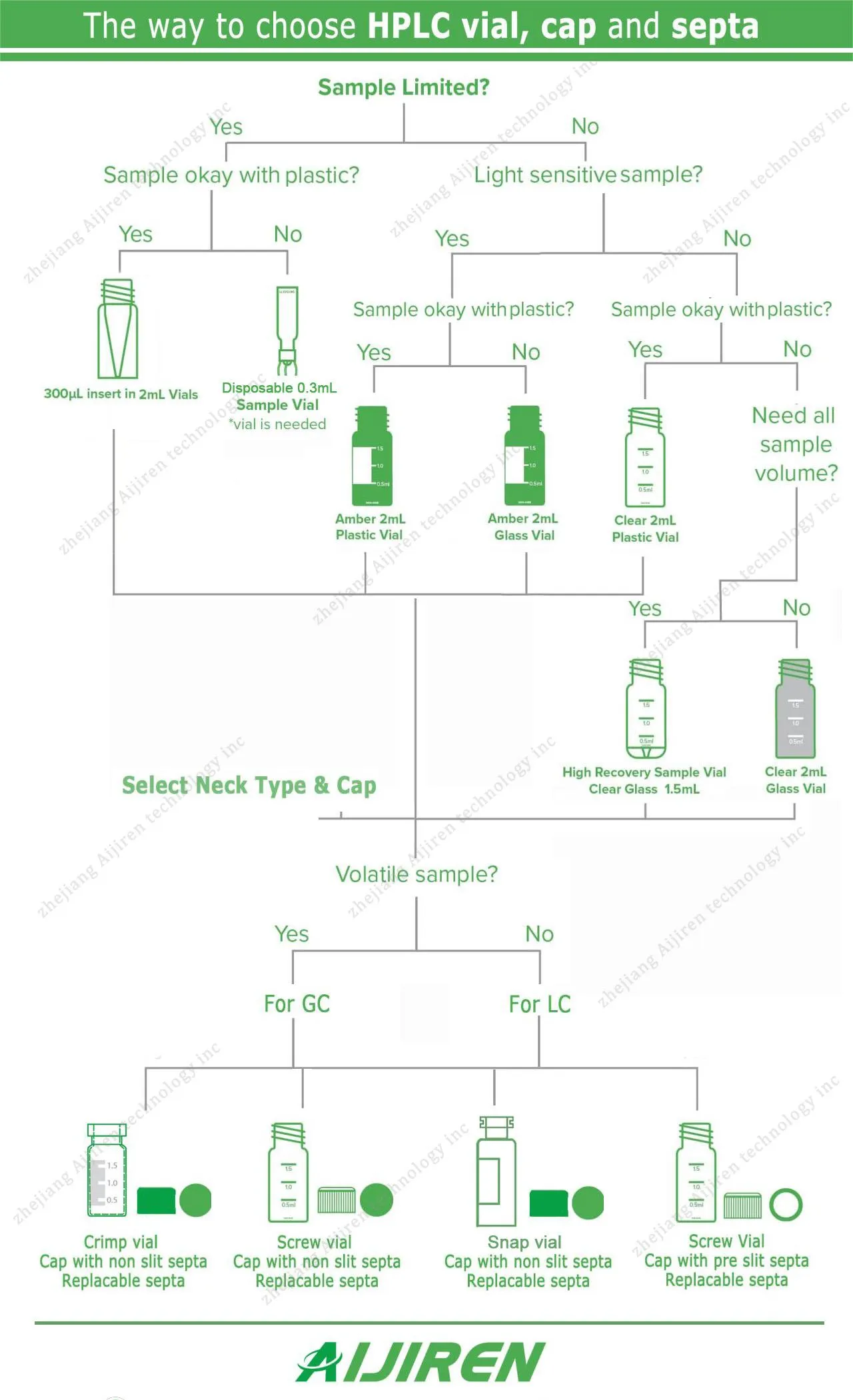
We often encounter some problems in the process of chromatographic analysis, such as Abnormal Chromatographic peaks, volatilization loss, etc. In fact, sometimes these problems are precisely brought about by the small HPLC vials
It is particularly important for experimental efficiency, the experimental process, and the accuracy of experimental data to choose and use sample vials correctly.

Step 1: Check your autosampler for compatibility
There are hundreds of autosamplers on the market to choose from, each with its own purpose and usage specifications. Some use a robotic arm to pick up vials, others use a rotating tray and aligning the sampling needles with the vials.
The robotic arm autosampler need to use the 9mm short thread vials for easy to pick up.
Although most autosamplers require a very specific vial size and closure type for proper usage, 9mm screw vial is the most widely used and compatible with most autosamplers on the market.
More details Reference our vial compatibility chart here
Step2: Know the chemical properties of your sample—decide the color and material of vials
For sample analysis, there are glass vials and plastic vials for common choice. They both have clear and amber color. You need to know more about your sample before choosing.
- 1. Is your sample light-stable or light-sensitive?
If your sample is sensitive to UV light, then you definitely need to use amber color vials for protecting your sample.
Otherwise, clear vials is better choice for observing your sample.
2. Will it be sensitive and stick to the glass?
Glass is a common choice for most labs since it is pure and more heat resistant than plastic.
However if your sample is sensitive, or stick to the glass, plastic vials should be your better choice.
Plastic vials offer better chemical resistance and lighter construction, while also being a more economical choice.
3. Does yoursamples need to be heated?
For analysis at room temperature, both plastic and glass bottles can be used.
The heat resistance temperatures of plastic vials and plastic caps is -20℃~60℃
Glass vials and aluminum caps can be heated up to 200℃.
The glass vials with metal caps will be your better choice when your samples need to be heated.
4. Evaluate your sample volatility and stability
For LC and LC/MS analysis with low sample volatility, screw top vial and snap top vial are mostly selected.
For the analysis of samples containing volatile or semi-volatile substances for GC and GC/MS analysis, crimp top vials are often chosen because of the better sealing.
Step 3: Choose the proper finish type
There are three types of HPLC vials: Screw top vial, Crimp top vial and Snap top vial.
Screw top vials are the most widely used vials available today, providing an excellent seal and easy assembly without any tool.
Crimp top vials have the best sealing effect, which can effectively prevent sample evaporation, however it need to use a crimper to complete the sealing
Caps of snap vials are simply applied and removed, no special tools required. However, the seal is less secure than crimp or screw cap. And the cap can sometimes break due to pressing pressure.
| FINISHTYPE | SEALING EFFECT | TOOL | CAP MATERIAL |
| Crimp Finish | Excellent | Crimper need | Aluminum |
| Screw Finish | Excellent | No need | PP |
| Snap Finish | Medium level | No need | PE |
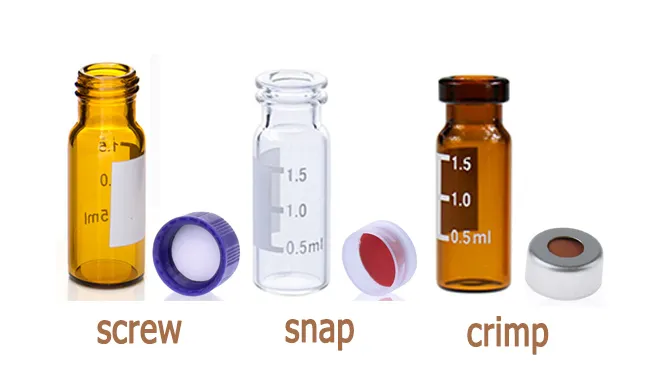
Step 4: Determine Volume of Vial
Have you ever met this question : this vial is 1.5ml, but I need a 2ml vials?
Actually the autosampler vial, no matter 1.5ml, 2ml, or 1.8ml, is the same one with the size of 12 x32mm, just a difference in calling habits of different places.
The most common sizes for HPLC vials are 2ml and 4ml (wash vial for wash needles).
For limited amount of sample analysis, you could also choose 0.3ml micro vials integrated with micro inserts, base bonded.
Another economical choice for micro analysis is use vial insert together with 2ml hplc vial.
There are three types of inserts: conical insert, conical insert with spring, and flat -bottom insert.
The conical insert with spring could automatically align the vial top, effectively relieve the pressure of the injection needle, and enable low residual micro analysis.
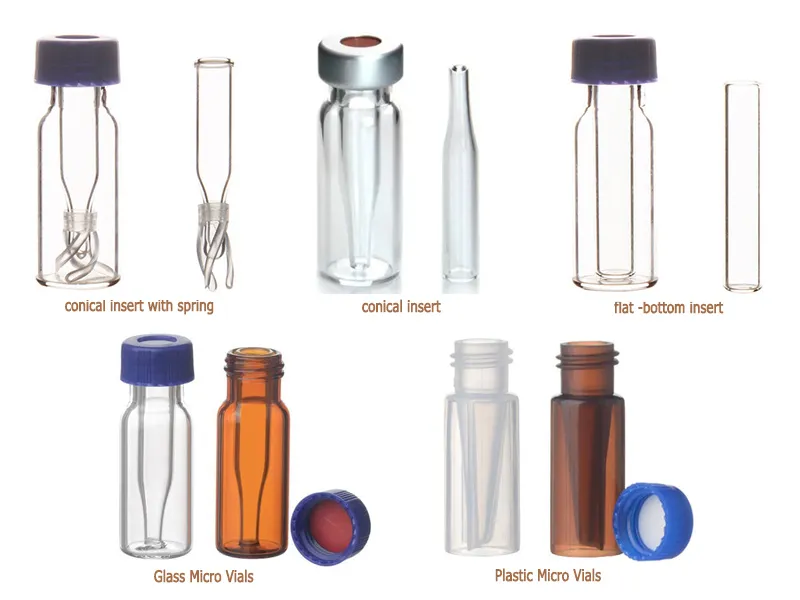
Step 5: Choose the proper caps and septa
The vial closure has two parts: caps and septa, which are often used together.
Vial caps are mainly divided into open top caps and solid caps.
Solid caps are mainly used for storing samples, while open top caps are mainly used for sample injection analysis.
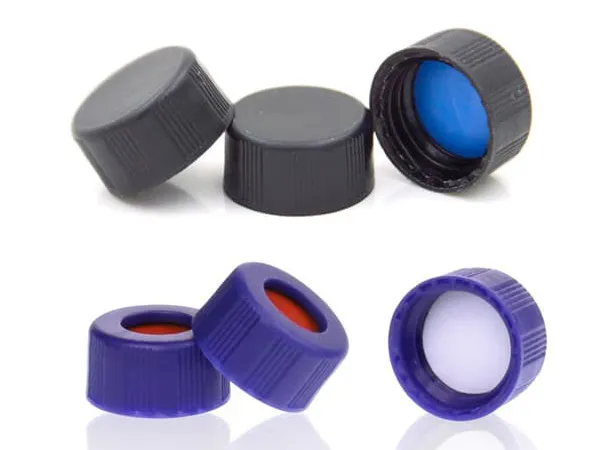
The septum is mainly composed of ptfe and silicone, PTFE has excellent chemical resistance, and silicone has excellent re-sealability.
We offer the following types of septum:
ptfe/silicone septa: The most commonly used type of septa, excellent resealability. However sometimes creates debris or the gasket falls into the sample and contaminates the sample.
ptfe/silicone/ptfe septa: More stable physical and chemical properties than common septa.
pre-slit septa: Easier to puncture and less likely to produce debris that can clog needles and contaminate samples.
bonded septa with cap: The septa is bonded to the cap to prevent the septa from falling off during use.
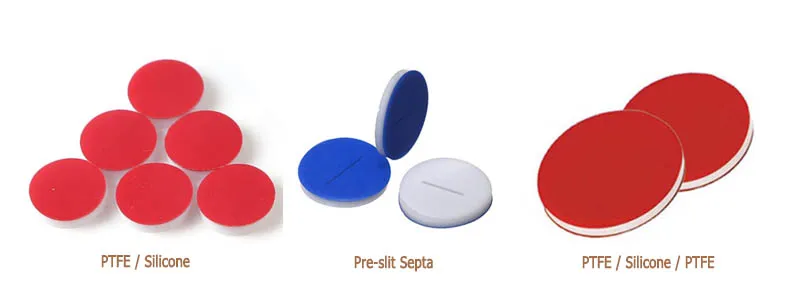
Reference the septa compatibility chart here
At Aijiren, we are committed to helping our customers determine the best sample vials for their chromatography analysis – contact our HPLC vial experts today.
Frequently asked questions about HPLC vials: FAQ
- 1. HPLC vials: reuse or discard?
Avoid reusing them, as some samples contain mostly biological materials (lipids, proteins), the vial is probably not 100% clean even after washing with organic solvents.
2. How high can glass HPLC vials be heated?
The glass vials and the septa can be heated to 200 Celsius. However the plastic caps only can stand 60 Celsius. So metal caps will be a better choice when it need to be heated.
3. What is the recommended fill volume for HPLC vials?
The recommended fill volume for HPLC vials is typically 70-80% of the total capacity of the vial. Overfilling can cause issues with injection accuracy and sample carryover.
4. What is the recommended storage temperature for HPLC vials?
HPLC vials should be stored at room temperature, away from direct sunlight and sources of heat.


